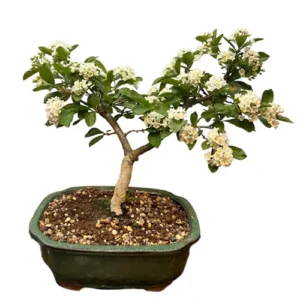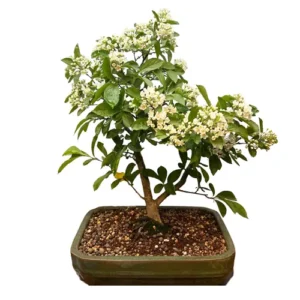Zelkova serrata
Japanese Grey Bark Elm Bonsai
Native to South Korea, China and Japan. This deciduous species also known as ‘Keyaki’ is elegant and easy to train. Its serrated dark green leaves go from lush green in Spring to a vibrant orange in the autumn. Zelkova provide a natural broom shape perfect for Bonsai.
Japanese Grey Bark Elm Bonsai Care Tips
Placement
Place your Japanese Grey Bark Elm in an outdoor full sun spot throughout the growing season. During the hottest weeks, it may be worth provide some shade if the sunlight is particularly intense. This bonsai requires some frost protection during winter, a frost-free greenhouse or shed is advisable.
Watering
Across the growing season, water your Zelkova frequently but be careful not to overwater. More regular watering should take place in the summer than in Spring and Autumn. Let the surface dry between waterings but not any further. In winter, keep the soil just moist.
Feeding & Fertilising
Throughout the growing season apply a solid feed once a month. A liquid feed once a week can be used as an alternative.
Pruning & Wiring
Pruning your bonsai is important not only to create or maintain an aesthetic style but to also ensure optimal health. Cut four to six leaves of the new shoots back to 2 leaves. Young zelkova should be defoliated in June. Prune thick twigs and overgrown long shoots after the leaves have fallen. An older tree can have its larger leaves removed to make room for more light.
Wiring can take place in winter, autumn, or spring. Young twigs that grow unruly need correcting for a broom style. To do this tie branches and twigs together in bundles during autumn. Remove the wire before the buds open in Spring. We recommend using wires with a thickness that matches the thickness of the branch: if the wire you choose is too thick you will damage the bark. If it is too thin, it won’t be effective.
Repotting
Repotting your tree is an important way to provide a fresh and suitable soil mix and ensure appropriate root health. Japanese Grey Bark Elm require repotting every two to three years. Roots require pruning carefully. Older species need repotting less frequently. Use a shallow rectangular or oval pot.
Trees that are ready for repotting will require root pruning, a suitable new pot and appropriate soil mix.
When repotting, do not cut back the root mass by a large amount, and choose a well-draining soil mix that has a neutral or slightly higher PH value of 5-6 but not over 7. We tend to use a mixture of different speciality bonsai soils on our trees. Every species is different so please contact us for free soil-mix advice or to take advantage of our repotting service.
Bonsai trees aren’t only magnificent additions to an indoor oasis, they are more than capable of standing out in any garden. Many Bonsai species are incredibly hardy and withstand nature’s colder and damper turns with aplomb making them worthwhile outdoor plants. We have an extensive library of care guides for outdoor bonsai trees. It’s not about selecting the perfect bonsai, it’s about selecting the perfect bonsai for you.
Japanese Grey Bark Elm Bonsai - Typical Queries
How to propagate Japanese Grey Bark Elm bonsai?
Japanese Grey Bark Elm can be propagated through seeds, cuttings and layering. For greenwood cuttings this is best done in the summer, hardwood cuttings are best done in the winter. Air layering is the choice of layering method to be used.
Do Japanese Grey Bark bonsai get pests and diseases?
Generally speaking, Japanese Grey Bark Elm is not particularly affected by health issues. In rare instances, leafhoppers, gall mites, aphids, spider mites and leaf spots may arise. Particular pesticides may be needed if any of these occur.
Can you keep a Dawn Redwood bonsai indoors?
This bonsai can be grown and placed indoors. As a deciduous it enjoys a lot of light but if this can provided artificially, it will certainly benefit from the cold and frost protection indoor keeping will provide.





















